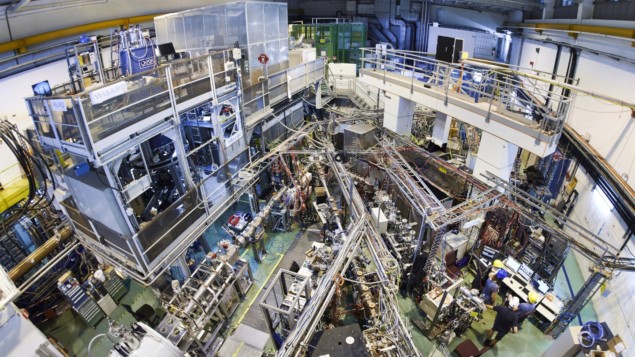
The first direct measurement has been made of a thorium-229 nuclear transition that could potentially form the basis for a “nuclear clock”. Done at CERN, the research follows a 2016 experiment that confirmed the transition’s existence but did not detect the resulting emitted photon. Much work remains before a working clock can be produced, but if such a device proves possible, it could prove an important tool for research in fundamental physics.
The most accurate clocks today are based on optically trapped ensembles of atoms such as strontium or ytterbium. Highly stable lasers are locked into resonance with the frequencies of specific atomic transitions, and the laser oscillations effectively behave like pendulum swings – albeit with much higher frequencies and therefore greater precision. These clocks can be stable to within 1 part in 1020, which means that they will be out by just 10 ms after 13.7 billion years of operation – the age of the universe.
Atomic clocks are not just great timekeepers, physicists have used them to study a range of fundamental phenomena such as how Einstein’s general theory of relativity applies to atoms confined in optical traps. In search of ever greater precision and deeper insights, in 2003 Ekkehard Peik and Christian Tamm of Physikalisch-technische Bundesanstalt in Braunschweig, Germany proposed that a clock could be produced by interrogating not electronic energy levels of atoms but nuclear energy levels.
Much smaller antenna
Such a nuclear clock would be extremely well isolated from external noise. “An atom is something like 10-10 m [across]; a nucleus is something like 10-14 or 10-15 m,” explains Sandro Kraemer of KU Leuven in Belgium, who was involved in this latest research. “The nucleus is a much smaller antenna for the environment and is thus much less prone to shifts.”
A nuclear clock might therefore be an excellent probe of hypothetical, very tiny temporal variations in the values of fundamental constants such as the fine structure constant, which quantifies the strength of the electromagnetic interaction. Any such changes would point to physics beyond the Standard Model. Moreover, nuclear binding is stronger than its atomic counterpart, so the shifts between energy levels are higher in energy and would be resonant with higher-frequency lasers, making a smaller change detectable.
This is a double-edged sword, however, as most nuclear transitions occur at much higher frequencies than can be produced by today’s lasers. Thorium-229, however, has a metastable excited state around 8 eV above the ground state – a transition that lies in the vacuum ultraviolet.
Suitable for excitation
Kraemer explains that building a laser to excite this state should just about be possible, “Out of 3000 or so radionuclei we know today, thorium is the only one we know that has a state suitable for laser excitation”.
First, however, researchers need to know the exact frequency of the transition. Indeed, the decay had long been predicted by theory, but attempts to detect the photon emitted had proved unsuccessful. In 2016, however, researchers at Ludwig Maximilian University of Munich indirectly confirmed its existence by measuring the emission of electrons in a process called internal conversion, in which the energy of the nuclear decay ionizes the atom.

Physicists measure energy of lowest nuclear excited state
Now, Kraemer and colleagues have made the first direct detection of the emitted vacuum ultraviolet photons by studying excited thorium-229 ions. The underlying idea is not new, Kraemer says, but previously researchers have tried to do this by implanting uranium-233 into crystals, which can decay to the excited thorium-229. The problem, says Kraemer, is that this releases over 4 MeV of energy into the crystal, which “is good for killing cancer, but really bad for us” as it damages the crystal, interfering with its optical properties.
In the new work therefore, the researchers used CERN’s ISOLDE facility to implant actinium-229 ions into magnesium fluoride and calcium fluoride crystals. These can decay to the metastable excited thorium-229 nucleus by β-decay, which releases four orders of magnitude less energy into the crystal. The researchers could therefore detect the photons and measure the transition energy. The final precision is still well short of the uncertainty needed to build a clock, and the researchers are now working with laser physicists to refine this.
Kyle Beloy of the US National Institute for Standards and Technology is impressed by the measurement. “There is very significant potential for this thorium-229 system as a nuclear clock and even more so to do tests of fundamental physics eventually,” he says. “In this [work], they observe a photon as it is emitted from the excited state down to the ground state, and ultimately the goal of the community here is to do the reverse. The narrow band of frequencies that the nucleus will absorb is on the order of millihertz, whereas how well we know that is on the order of 1012 Hz, so it’s like a needle in a haystack, and essentially what they’ve done is to reduce the size of the haystack by a factor of seven. That’s a big step forward for anyone searching to excite the transition.”
The research is described in Nature.



